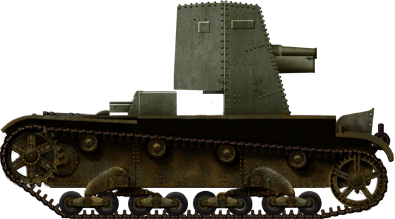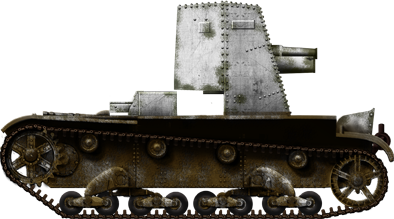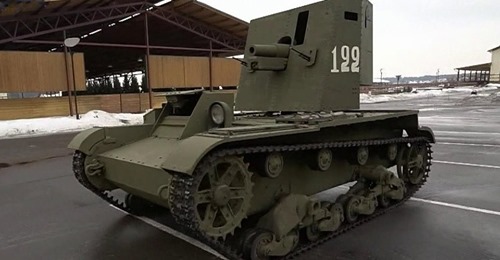Development of the SU-26
World War I proved the potency of weapon platforms for support, defence and assault and with a wide variety of gun types. They were used generally in directly fire in line of sight and the concept resurfaced in World War II with such specialists as the StuG III, M7 Priest (SPG) or SU-76 combined aspects of assault and classic artillery role. In USSR the T-26 (a mass produced copy of theVickers 6 Ton tank) introduced in 1931, already was tested as SPG (SU-1) but it seldom made it in production.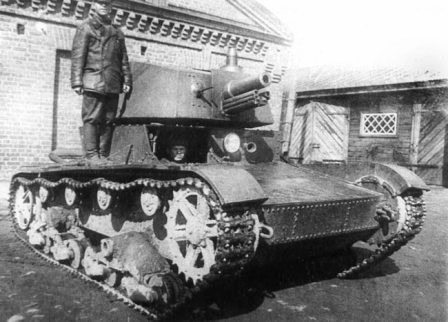
The T-26 with A-43 turret, was a model 1931 with a welded turret developed by N. Dyrenkov, here tested in Leningrad, 1933. It sported the 76 mm divisional gun.
After the SU-1 (single prototype) two AT-1 with casemate were ordered and built, 10 planned then cancelled, both having casemates. There was the SU-5-1, a prototype with the 76 mm divisional gun M1902/30 in open-top structure, one tested in 1934. SU-5-2 sported the 122 mm howitzer mod. 1910/30 also in an open-top structure tested in 1934 and 30 more built in 1936 (future post). Then came the SU-5-3 with an even more impressive 152.4 mm divisional mortar mod. 1931 also in an open-top hull, tested the same year of 1934. Finally in 1935 was created the SU-6, also a a Self-propelled gun, but armed with a 76.2 mm 3K anti-aircraft gun and open-top structure. 4 more vehicles received instead a 37 mm anti-aircraft automatic gun were cancelled in 1936.
The rush toward a SPG that was quick to produce quickly, cheaply, had to wait for the disaster at Barbarossa in the summer of 1941. German troops approached Leningrad by Late September 1941, and some believed using obsolete tanks for other usses and improvized types. By 5 August 1941, Plant 174 presented a new Assault Gun to The Military Council Of The Leningrad Military District, called the T-26-6. Troops were indeed crying for direct fire support weapon and there was no shortage of T-26 tank hulls. On August 11th, it was greenlight, and 24 hulls were earmarked for conversion.
SU-26 Design
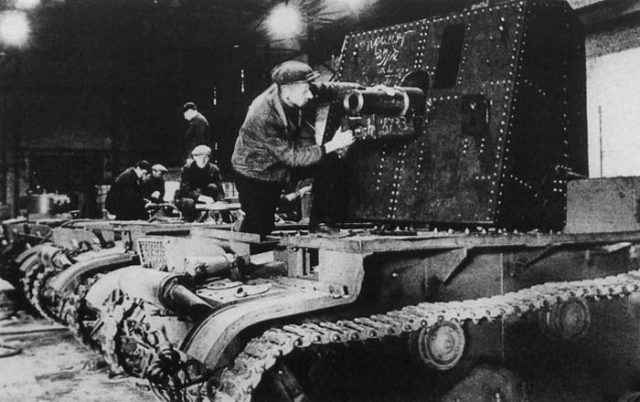
Hull and general Layout
The conversion made of the regular T-26 an Assault Gun was armed with a 76.2 mm (3 in) KT-28 gun (derived from the 1927 Regimental Gun). The engine deck were redesigned so to create a flat platform large enough for a large gun shield and operators to walk around. The traversable mount had a shiled quite tall, but only capable of protecting the crew crouching, right in the center of the shield. The driver's compartment stayed but the main boxy structure that was the former fighting compartment was removed.The gun shield was holed in the center in order to fit the KT-28 gun and it was seconded by two small ports either sides, for extra DT-29 machine guns to be placed in close defence. Unusually the mount faced to the rear for greater crew mobility and voiding blinding the driver, although it can be fire forwards if needed. The gun was high enough above the hull to avoid severe blast effects.
Production started but was cancelled as T-26 tanks were unrgently needed, and some eight ended as Flame Throwing Tanks. In the end only 14 of these were made at Leningrad Plant They were known as SU-T-26s, T-26-SU but SU-26 became pupular albeit SU-76 was recorded in the Red Army ands then changed for SU-76P (Regimental) as the new SU-76 based on the T-70 light tank appeared. The name regimental was linked to the KT-28, a Regimental Gun. More on this gun, also called Regimental Gun Mod. 1927.
SU-26 specifications | |
| Dimensions (L-w-h) | As T-26 |
| Total weight | 12 tonnes |
| Crew | 4 (Driver, Commander, Gunner, Loader) |
| Propulsion | T-26 Carburetor, 4 Cylinder, 90 hp |
| Speed | As T26 |
| Range | As T26 |
| Armament | KT-28 Rgt. gun 76.2mm, optional DT-29 LMG |
| Armor | 10-20 mm (0.39-0.79 in) |
| Total production | 14 |
Operational records are scarce. It is known that the 124th Armored Brigade received two SU-26 in the 37 mm gun versions, while three 3 in were later lost in combat. The 220th Tank Brigade had four 76 mm versions. Early 1942 saw it used with the 122th Tank Brigade. Some soldiered as long as 1944 in the Leningrad pocket.
Src read more
On Tank Encyclopediawarspot.ru

WW2 Tanks




























WW2 tanks posters

All Tiger tanks liveries.

Panther liveries and variants

WW2 Armour - All tanks











Tanks aces and single tanks series

Find more there

Museums, Movies, Books & Games
The Tanks and Armor in pop culture
Tanks and armored vehicles in general are only really grasped when seen first person: The mass, the scale, it's all there. Explore also the way tanks were covered in the movie industry, in books and in video games.Movies:
Best tanks movie on warhistoryonline.com
On imdb.com
On bestsimilar.com/
miltours.com
liveabout.com/
watchmojo.com
Video Games:
pcgamesn.com
historyhit.com
levvvel.com
vg247.com/best-tank-games
mmobomb.com/
alienwarearena.com

